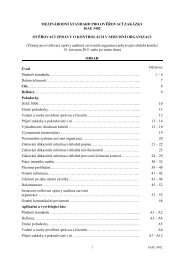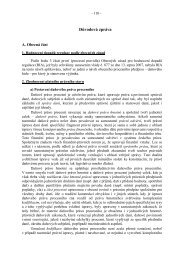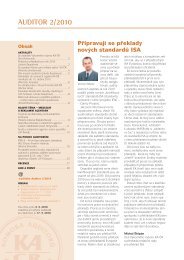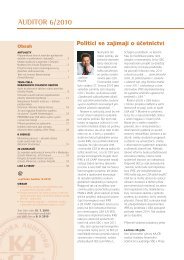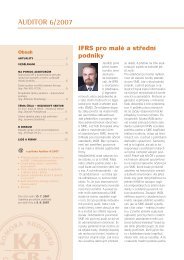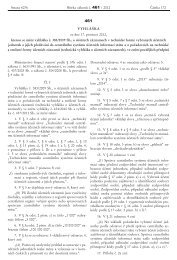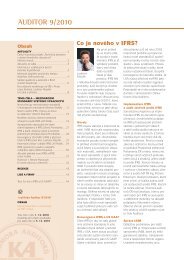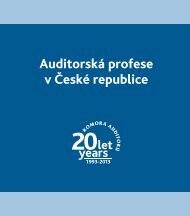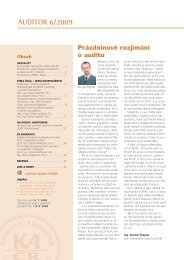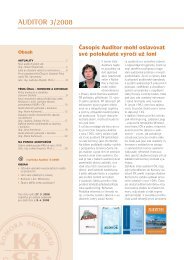Guide to Using International Standards on Auditing in - IFAC
Guide to Using International Standards on Auditing in - IFAC
Guide to Using International Standards on Auditing in - IFAC
Create successful ePaper yourself
Turn your PDF publications into a flip-book with our unique Google optimized e-Paper software.
123<br />
<str<strong>on</strong>g>Guide</str<strong>on</strong>g> <str<strong>on</strong>g>to</str<strong>on</strong>g> <str<strong>on</strong>g>Us<strong>in</strong>g</str<strong>on</strong>g> <str<strong>on</strong>g>Internati<strong>on</strong>al</str<strong>on</strong>g> <str<strong>on</strong>g>Standards</str<strong>on</strong>g> <strong>on</strong> <strong>Audit<strong>in</strong>g</strong> <strong>in</strong> the Audits of Small- and Medium-Sized Entities Volume 1—Core C<strong>on</strong>cepts<br />
statements with an expectati<strong>on</strong> developed from <strong>in</strong>formati<strong>on</strong> obta<strong>in</strong>ed from understand<strong>in</strong>g the entity, and<br />
other audit evidence.<br />
If the <strong>in</strong>herent risks are low for a class of transacti<strong>on</strong>s, substantive analytical procedures al<strong>on</strong>e may provide<br />
sufficient appropriate audit evidence. However, if the assessed risk is low because of related <strong>in</strong>ternal c<strong>on</strong>trols,<br />
the audi<str<strong>on</strong>g>to</str<strong>on</strong>g>r would also perform tests of those c<strong>on</strong>trols. C<strong>on</strong>sequently for significant risks identified, analytical<br />
procedures would always be used <strong>in</strong> comb<strong>in</strong>ati<strong>on</strong> with other substantive tests or tests of c<strong>on</strong>trol.<br />
To use an analytical procedure as a substantive procedure, the audi<str<strong>on</strong>g>to</str<strong>on</strong>g>r should design the procedure <str<strong>on</strong>g>to</str<strong>on</strong>g><br />
reduce the risk of not detect<strong>in</strong>g a material misstatement <strong>in</strong> the relevant asserti<strong>on</strong> <str<strong>on</strong>g>to</str<strong>on</strong>g> an acceptably low level.<br />
This means that the expectati<strong>on</strong> of what the recorded amount should be is precise enough <str<strong>on</strong>g>to</str<strong>on</strong>g> <strong>in</strong>dicate the<br />
possibility of a material misstatement, either <strong>in</strong>dividually or <strong>in</strong> the aggregate.<br />
CONSIDER POINT<br />
For audit-plann<strong>in</strong>g purposes, substantive analytical procedures may be grouped <strong>in</strong><str<strong>on</strong>g>to</str<strong>on</strong>g> three dist<strong>in</strong>ct<br />
levels based <strong>on</strong> the level of assurance obta<strong>in</strong>ed. These are described below.<br />
Exhibit 10.4-1<br />
Impact <strong>on</strong><br />
Reduc<strong>in</strong>g<br />
Audit Risk<br />
Highly Effective<br />
(Low Level of Risk<br />
that the Recorded<br />
Amount is<br />
Misstated)<br />
Moderately<br />
Effective<br />
Limited<br />
Descripti<strong>on</strong><br />
Procedure is <strong>in</strong>tended <str<strong>on</strong>g>to</str<strong>on</strong>g> be the primary source of evidence regard<strong>in</strong>g a f<strong>in</strong>ancial<br />
statement asserti<strong>on</strong>. It “effectively” proves the recorded amount. However, if the risk<br />
<strong>in</strong>volved is significant, it would be supplemented by other relevant procedures.<br />
Procedure is <strong>on</strong>ly <strong>in</strong>tended <str<strong>on</strong>g>to</str<strong>on</strong>g> corroborate evidence obta<strong>in</strong>ed from other procedures.<br />
A moderate level of assurance is obta<strong>in</strong>ed.<br />
Basic procedures, such as compar<strong>in</strong>g an amount <strong>in</strong> the current period <str<strong>on</strong>g>to</str<strong>on</strong>g> a previous<br />
period, are useful but <strong>on</strong>ly provide a limited level of assurance.<br />
Techniques<br />
There are a number of possible techniques that can be used <str<strong>on</strong>g>to</str<strong>on</strong>g> perform the analytical procedures. The<br />
objective is <str<strong>on</strong>g>to</str<strong>on</strong>g> select the most appropriate technique <str<strong>on</strong>g>to</str<strong>on</strong>g> provide the <strong>in</strong>tended levels of assurance and<br />
precisi<strong>on</strong>. Techniques <strong>in</strong>clude:<br />
• Ratio analysis;<br />
• Trend analysis;<br />
• Break-even analysis;<br />
• Pattern analysis; and<br />
• Regressi<strong>on</strong> analysis.




